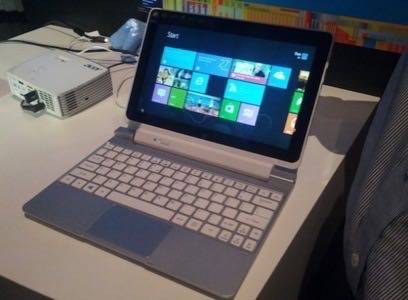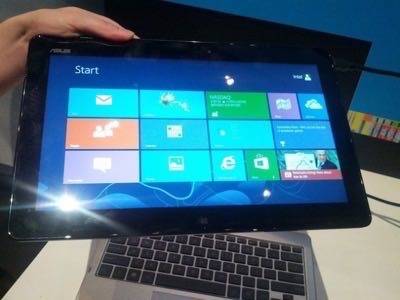
Intel introduced a new wrinkle into the Windows 8 tablet market on Thursday by launching an upgrade of its entry-level Atom chip line best known for (under)powering netbooks. The more powerful but still low-cost Windows 8-compatible microprocessor challenges the need for Windows RT tablets powered by ARM chips.
At the debut of the new Atom processor in San Francisco, a number of Intel’s key partners were on hand to show off Windows 8 convertible tablet designs running on the new chip. But while the event provided a peek into at least some of their hardware plans a month or so before Windows 8’s launch, most key details – including prices – remained mysteries and the OEMs offered little to distinguish their products from one another.
However, one thing is clear – Intel’s Atom processor, once dismissed as an obscure product for netbooks, set-top boxes and other embedded designs, has emerged as a significant force in Intel’s product lineup.
All-Day Computing, For Windows 8
Moreover, the new Atom chip, code-named “Clover Trail,” is intended to put a serious dent in the value proposition of the ARM chips that wil run devices using Windows 8’s little brother, Windows RT (see 15 Things You Need To Know About Windows RT). Not only are the Atom chips based on the X86 architecture, allowing them to run Windows 8 and other PC applications, but they promise true all-day battery life. Undocked, tablets like the Acer Iconia W510 claims ten hours of battery, for example. Docked into a keyboard base, though, an integrated battery adds an additional nine hours of battery, for a total of nineteen hours. That’s a long workday for anyone.
Furthermore, the new Atoms offer “connected standby” technology, where they can sit idle for up to three weeks, waking up just often enough to update email, Twitter and/or Facebook status updates, then drop back into a low-power sleep state.
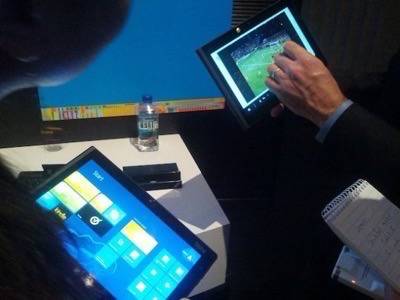
The addition of the Z2760 extends the continuum of Intel mobile chips, from the new Atom at the low end all the way on up to the Core i3, i5, and i7 processors. At the top will be notebooks and presumably tablets powered by the Intel Core i7 with VPro, Intel’s virtualization and security hardware package. It also means that consumers will have to wade through yet another option when choosing a Windows 8 device.
“From an Intel perspective, there’s two levels,” explained Patrick Moorhead, president of Moor Insights and Strategy in Austin, Texas. “You’ve got the Atom at the entry level, and really what you’re looking at is decent performance, great price and great battery life. And as you move up the stack, you get better performance, more expensive, less battery life, but you’re getting your performance where it makes a difference.”
Broad Customer Support
Eight tablet makers, including Dell, Hewlett-Packard, Lenovo and Samsung, all showed off convertible tablets based on the new chip. Some, like Dell, said that its Z2760-based tablet, the Latitude 10, were built for business. While Intel executives showed the Atom chip powering a few games, its graphics horsepower will probably be underwhelming, analysts said. (HP’s Ali Khan, a senior consumer marketing manager, said that its HP Envy X2 will include CyberLink’s PowerDirector video-editing package, and that the Z2760 “handled that just fine”.) Limited graphics power will probably make Atom-powered tablets more suitable for business, with vertical markets like manufacturing and healthcare.
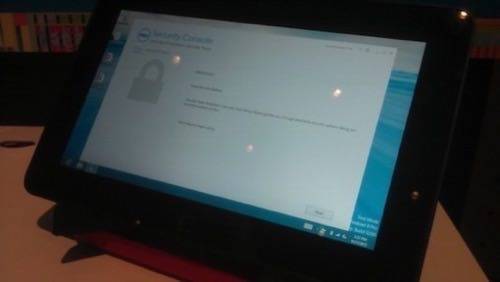
“I think most of these guys are going to have to target the enterprise,” said Mario Morales, an analyst with IDC. “You heard most of these guys talk about consumer applications, because what I think Windows is trying to do is bring in a lot more of those apps. But the enterprise has more of an opportunity.”
Tim Gee, a senior product marketing manager for Dell, said that his company hasn’t yet announced a Core i5 tablet; the Clover Trail-based Latitude 10 will be the “best for business,” Dell executives said. Microsoft’s full-fledged Surface tablet, as opposed to the Windows RT version, will use a Core i5 chip. (See Why Microsofts Surface Pro Will Be The First Real Business Tablet.)
“It’s probably more of a continuum, as people evolve in their computing needs,” Gee said of Dell’s approach to Intel’s processor offerings. “The Atom processor is being designed for tablets, and as you get long battery life, 8 to 10 hours, and then you get fanless environments, so you get nice and thin form factors, then as you go up in the continuum up to Core i3, i5, i7, that’s when you get into more traditional computing, more traditional notebooks, day-to-day productivity.”

Gee wouldn’t comment on the price of the Dell Latitude 10. However, the Latitude 10 is the second Atom-based tablet Dell has launched, following the release of the Dell Latitude ST last fall. That tablet was priced at $679.
What This Means For Windows RT
Samsung, on the other hand, designed its Series 5 smart PC convertible tablet for the consumer market. That aims the Series 5 directly against Windows RT tablets like the Surface, something that Samsung executives said that they were reluctant to do. And that left the company’s Windows RT plans up in the air.
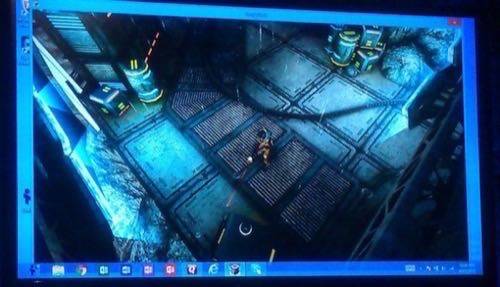
“I think the jury’s still out,” Bret Berg, senior business development director for Samsung, told ReadWriteWeb about Windows RT. When asked whether or not that meant Samsung or the industry at large, Berg replied, “Yes.”
“It’s going to be a real challenge for Microsoft, because it’s really a different operating system,” Berg added. “And now you’re not going to be competing with [the Series 5], you’re going to be competing with the iPad, the [Samsung] Galaxy Tab. And how are we going to be competing? Price-wise. Are we going to be on a par with them? If we aren’t, that’s going to be legitimately a challenge.”
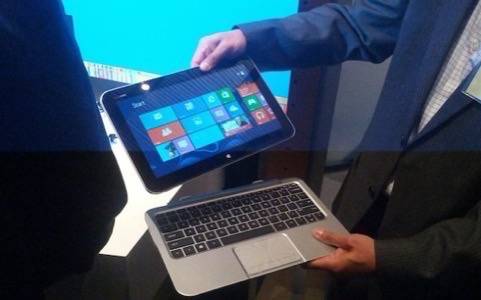
Samsung’s Smart PC contains the Clover Trail chip, 64 GB of flash storage, an 11.6-inch display, and weighs 3.26 pounds in a clamshell configuration. The company is also one of the first to announce a price: $649 plus another $100 for the keyboard dock.
Asus assistant marketing manager Xi Min Sam also said his company would focus on the consumer market, where it will offer an 11.6-inch version of its Clover Trail-based VivoTab for Windows 8, and a smaller 10.1-inch version for Windows RT. But Asus’ strategy is to cover all of its bases, and the two tablets will provide a Windows option to the more well-known Eee Transformer series of Android tablets.
Finally, Intel’s Erik Reid, the general manager of its application processor platform division, also diffused a minor controversy from earlier in the week, where Bloomberg quoted a source at Intel who claimed that Paul Otellini had dismissed Windows 8 as buggy and not ready for release. That prompted an official criticism of “unsubstantiated news reports”. “We could not be more excited about Windows 8… and that was the message that Paul communicated to the employees this week,” Reid added.
The Clover Trail Tablet Lineup
Other Intel Z2760-based Cedar Trail tablets include:
- The Acer Iconia W510: Dockable 10.1-inch screen, 1.27 pounds (2.78 pounds docked). 32GB or 64 GB storage. 18-hour battery life with dock. Connectivity options include SIM card, microSD, microUSB, HDMI and a full-size USB connector.
- The Asus VivoTab: Dockable 11.6-inch IPS+ screen, 64 GB storage, 1.51 pounds undocked. 8-megapixel rear camera. Wacom digitizer.
- Dell Latitude 10: Dockable 10-inch display, 1.59 pounds, removeable battery.
- HP Envy X2: Dockable 11.6-inch display, 1.5 pounds (3.1 pounds docked). Beats Audio, NFC.
- Lenovo ThinkPad 2 tablet: 10.1-inch display, 10-hour battery life, digitizer pen. Full-sized USB port. Business-oriented tablet allows guest accounts, joining the corporate domain and runing business apps.
- ZTE V98 tablet: Less than 1.54 pounds. 2GB RAM and 32GB storage. LTE, UMTS and Wi-Fi options. Front-facing 2-megapixel camera and rear-facing 8-megapixel camera.
